Navman REPEAT 3100 User Manual
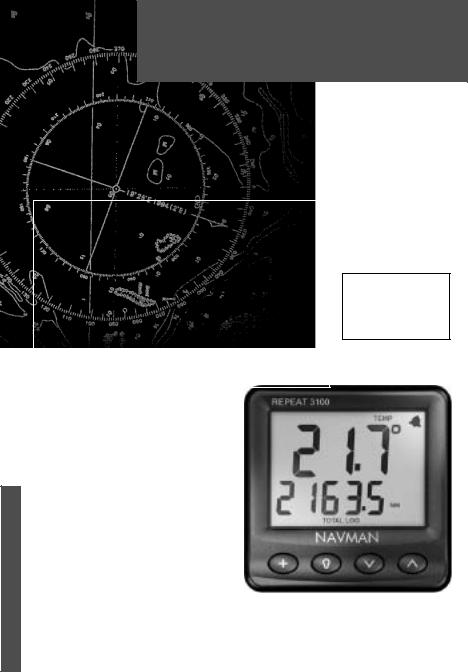
REPEAT 3100
Installation and
Operation Manual
DRAFT |
|
|
|
English ............. |
2 |
Approved by translator |
|
|
|
Français ......... |
15 |
|
Español .......... |
27 |
Approved by Plastimo |
|
|
|
Português ...... |
39 |
This document is still under review and is subject to change. |
|
|
Each completed stage to be marked with |
|
|
w w w . n a v m a n . c o m

NAVMAN

FCC Statement
Note: This equipment has been tested and found to comply with the limits for a Class B digital device, pursuant to Part 15 of the FCC Rules. These limits are designed to provide reasonable protection against harmful interference in a normal installation. This equipment generates, uses and can radiate radio frequency energy and, if not installed and used in accordance with the instructions, may cause harmful interference to radio communications. However, there is no guarantee that interference will not occur in a particular installation. If this equipment does cause harmful interference to radio or television reception, which can be determined by turning the equipment off and on, the user is encouraged to try to correct the interference by one or more of the following measures:
Reorient or relocate the receiving antenna.
Increase the separation between the equipment and receiver.
Connect the equipment into an output on a circuit different from that to which the receiver is connected.
Consult the dealer or an experienced technician for help.
A shielded cable must be used when connecting a peripheral to the serial ports.
2 |
NAVMAN REPEAT 3100 Installation and Operation Manual |

Contents |
|
1 Introduction ..................................................................................................... |
4 |
2 Operation ......................................................................................................... |
5 |
2-1 Turning on and off ....................................................................................................... |
5 |
2-2 The keys and backlight ................................................................................................ |
5 |
2-3 Changing the data displayed ........................................................................................ |
5 |
2-4 Changing units ............................................................................................................ |
6 |
2-5 Simulate ...................................................................................................................... |
6 |
2-6 Key reference .............................................................................................................. |
6 |
3 Systems of several instruments .................................................................... |
7 |
3-1 NavBus ....................................................................................................................... |
7 |
3-2 NMEA ......................................................................................................................... |
7 |
4 REPEAT 3100 hardware .................................................................................. |
7 |
4-1 What comes with a REPEAT 3100 .............................................................................. |
7 |
4-2 Other parts required .................................................................................................... |
7 |
4-3 Accessories ................................................................................................................. |
7 |
5 Installation and setup ...................................................................................... |
8 |
5-1 Installation ................................................................................................................... |
8 |
5-2 Setup ......................................................................................................................... |
10 |
5-3 Resetting to factory defaults ...................................................................................... |
10 |
Appendix A - Specifications ............................................................................. |
11 |
Appendix B - NMEA function table ................................................................. |
12 |
Appendix C - Troubleshooting ........................................................................ |
14 |
Appendix D - How to contact us ..................................................................... |
51 |
Important
It is the owner's sole responsibility to install and use the instrument in a manner that will not cause accidents, personal injury or property damage. The user of this product is solely responsible for observing safe boating practices.
NAVMAN NZ LIMITED DISCLAIMS ALL LIABILITY FOR ANY USE OF THIS PRODUCT IN A WAY THAT MAY CAUSE ACCIDENTS, DAMAGE OR THAT MAY VIOLATE THE LAW.
This manual represents the REPEAT 3100 as at the time of printing. Navman NZ Limited reserves the right to make changes to specifications without notice.
Governing Language: This statement, any instruction manuals, user guides and other information relating to the product (Documentation) may be translated to, or has been translated from, another language (Translation). In the event of any conflict between any Translation of the Documentation, the English language version of the Documentation will be the official version of the Documentation.
Copyright © 2002 Navman NZ Limited, New Zealand, All rights reserved. NAVMAN is a registered trademark of Navman NZ Limited.
NAVMAN REPEAT 3100 Installation and Operation Manual |
3 |
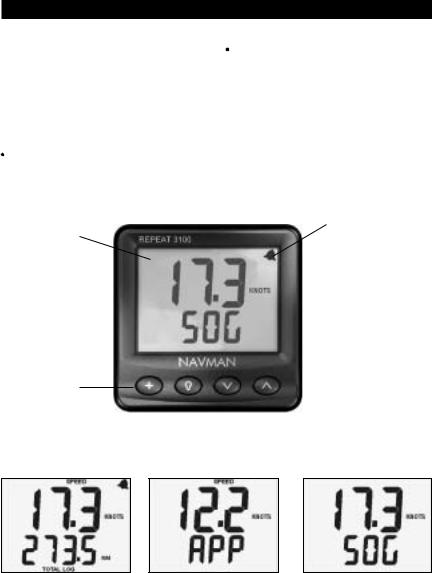
1 Introduction
The REPEAT 3100 is part of the NAVMAN 3100 series of instruments, which measure speed, depth, wind, water temperature, battery voltage and other functions. The REPEAT 3100 can display any data that is output from 3100 series instruments, as well as NMEA data from compatible instruments. The REPEAT 3100 can also act as a GPS repeater and provides a wealth of information on deck from a GPS situated in a more protected position, such as below decks.
The REPEAT 3100 can obtain its data in two ways:
From other 3100 Series instruments which are connected by NavBus (NavBus is NAVMAN’s
The REPEAT 3100 display unit
Display (backlit)
Four keys (backlit)
proprietary system for connecting marine instruments).
From a maximum of three instruments, such as NAVMAN’s TRACKER Chartplotter, that send compatible NMEA 0183 V2 data. When connecting the REPEAT 3100 to 3rd party instruments, ensure that the NMEA data being sent is compatible.
For maximum benefit, please read this manual carefully before installation and use.
Cleaning and maintenance
Clean the unit with a damp cloth or mild detergent. Avoid abrasive cleaners, petrol or other solvents.
Alarm symbol
Display shows Speed over Ground (SOG)
111 x 111 mm (4.4" x 4.4")
Display modes (see section 2-3)
Dual mode: two items of data from SPEED 3100, DEPTH 3100 or MULTI 3100
Wind mode: one item of data from WIND 3100
NMEA mode: one item of data from compatible NMEA instruments
4 |
NAVMAN REPEAT 3100 Installation and Operation Manual |
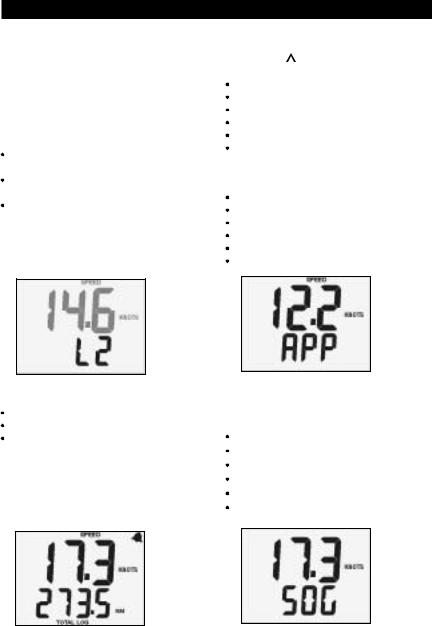
2 Operation
2-1 Turning on and off
Turn the unit on and off with the auxiliary power switch on the boat. The unit does not have its own power switch. When you turn the unit off, it retains any settings.
IfthewordSIM flashesatthe bottom,right ofthedisplay, then simulate is on (see section 2-5).
2-2 The keys and backlight
The unit has four keys, labelled +,  ,
,  and
and  . In this manual:
. In this manual:
Press means to push the key for less than one second.
Hold for two seconds means to hold the key down for two seconds or more.
Press one key + another key means to push both keys together.
Set backlight for screen and keys
You can set the backlight to one of four brightness levels or off. Press  once to display the current backlight level, press
once to display the current backlight level, press  again to change the level:
again to change the level:
Backlight level 2
2-3 Changing the data displayed
The display has three modes:
Dual mode displays speed or depth data.
Wind mode displays wind data.
NMEA mode displays data from compatible NMEA instruments.
To change mode, press + one or more times.
Note: If the display is dashes (— —) then it means that the data is not available or the instrument which sends the data to the REPEAT 3100 is turned off or disconnected.
Dual mode
Dual Mode displays two items of data at a time from a SPEED 3100, DEPTH 3100 or MULTI 3100. To change the item displayed in the top line of the display, press one or more times. The choices are:
Speed.
Avg speed.
Max speed.
Trim speed.
Depth.
Temperature.
To change the item displayed in the bottom line of the display, press  one or more times. The choices are:
one or more times. The choices are:
Speed.
Depth.
Trip log (distance).
Total log (distance).
Battery voltage.
Countdown timer.
Wind mode
Wind mode displays one item of data at a time from a WIND 3100. To change the item displayed, press  or
or  one or more times. The choices are:
one or more times. The choices are:
Apparent wind direction.
True wind direction.
Apparent wind speed.
True wind speed.
Max wind speed.
VMG.
NAVMAN REPEAT 3100 Installation and Operation Manual |
5 |
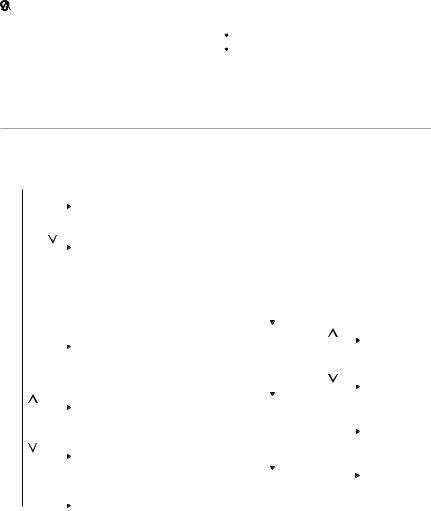
NMEA mode
NMEA Mode displays one item of data at a time from any compatible NMEA instrument. To select which NMEA data can be displayed, see section 5-2, step 2. To change the item displayed, press  or
or
one or more times.
2-4 Changing units
To change the units on the REPEAT 3100, change the units on the instrument which sends the data to the REPEAT 3100.
2-5 Simulate
Simulate allows you to become familiar with the REPEAT 3100 off the water. When simulate is on, the unit functions normally except that the data from other instruments is ignored and the unit generates this data internally. The word SIM flashes at the bottom, right corner of the screen if:
The REPEAT 3100 has simulate on.
Any instrument connected to the REPEAT 3100 by the NavBus has simulate on.
To turn simulate on or off in the REPEAT 3100:
1Turn the power off.
2Hold down +while you turn the power on.
2-6 Key reference Turn power on
Hold + |
|
Turn Simulate |
Hold |
on or off |
|
|
||
|
||
+ |
|
Reset to factory |
5 sec |
defaults |
|
Normal operation |
|
|
|
|
|
|
|
|
||
+ + |
|
|
|
Setup |
|
|
|
|
|
|
|
|
|
|
|
|
|
|
|
|
|
+ |
|
Change display mode, between |
|
Set Backlight |
|
|
|
Increase value |
||
|
Dual mode, Wind mode and |
|
Group |
|
|
|
or change |
|||
|
|
|
|
|
||||||
|
|
|
|
|
|
|
|
NMEA item |
||
|
|
NMEA mode |
|
|
+ + |
|
|
|
||
|
|
|
|
|
|
|
|
|
||
|
|
|
|
|
|
|
|
|
||
|
|
|
|
|
|
|
|
|
||
|
|
|
|
|
|
|
|
|
Decrease value |
|
|
|
|
|
|
|
|
|
|
or change |
|
|
|
|
|
|
|
|
|
|
||
|
|
|
|
|
|
|
|
|
NMEA item |
|
|
|
Change item of data displayed |
|
Select NMEA |
|
|
|
|
|
|
|
|
|
data to display |
|
|
|
|
|
||
|
|
|
|
|
|
|
|
|||
|
|
|
|
|
+ |
|
Turn NMEA |
|||
|
|
|
|
|
|
|
|
|||
|
|
|
|
|
+ + |
|
|
function display |
||
|
|
|
|
|
|
|
|
|||
|
|
|
|
|
|
|
|
|
ON or OFF |
|
|
|
Change item of data displayed |
|
|
|
|
|
|
||
|
|
|
|
|
|
|
|
|
|
|
|
|
|
|
|
|
|
|
|
|
|
|
|
|
|
|
|
|
|
|
Return to |
|
|
|
|
|
|
|
|
|
|
||
|
|
|
|
Set UTC offset |
|
|
|
normal |
||
|
|
|
|
(for time display) |
|
|
|
operation |
||
|
|
Adjust backlight |
|
|
+ + |
|
|
|
|
|
|
|
(4 levels or off) |
|
|
|
|
|
|
||
|
|
|
|
|
|
|
||||
|
|
|
|
|
|
|
|
|
|
|
6 |
NAVMAN REPEAT 3100 Installation and Operation Manual |
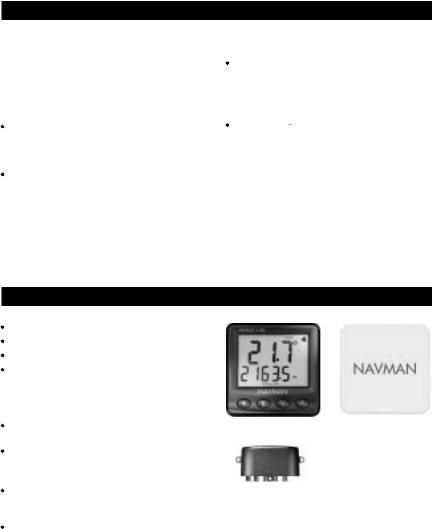
3 Systems of several instruments
Several NAVMAN instruments can be connected together to share data. There are two ways of connecting instruments together, NavBus or NMEA.
3-1 NavBus
NavBus is a NAVMAN proprietary system that allows systems of multiple instruments to be built using a single set of transducers. When instruments are connected by NavBus:
If you change the units, alarms or calibration in one instrument, then the values will automatically change in all other instruments of the same type.
Each instrument can be assigned to a group of instruments (see section 5-2, step 2). If you change the backlight in an instrument in group 1, 2, 3 or 4 then the backlight will automatically change in the other instruments in the same
group. If you change the backlight in an instrument in group 0 then no other instruments are affected.
If an alarm sounds, mute it by pressing  on any NAVMAN instrument which can display that alarm and which has a
on any NAVMAN instrument which can display that alarm and which has a  key. Alarms can not be muted from a REPEAT 3100.
key. Alarms can not be muted from a REPEAT 3100.
NavBus and the REPEAT 3100
The REPEAT 3100 will automatically read and display data from other instruments connected by NavBus.
3-2 NMEA
NMEA is an industry standard, but is not as flexible as NavBus as it requires dedicated connections between compatible instruments. The REPEAT 3100 can read and display NMEAdata output by up to three instruments (see Appendix B).
4 REPEAT 3100 hardware
4-1 What comes with a REPEAT 3100
REPEAT 3100 unit with protective cover.
Warranty card.
Mounting template.
This Installation and Operation manual.
4-2 Other parts required
One or more 3100 series instruments will be connected to the boat 12 V power supply via:
An accessory switch to turn the instruments on and off.
A fuse: Use a 1 A fuse for between one and five instruments.
The REPEAT 3100 can receive and display:
Data from other NAVMAN instruments connected via NavBus; settings for units and backlighting are shared (see section 3-1).
NMEA data from up to three compatible instruments (see section 3-2).
Wiring and connectors are required (see section 5 or the NavBus Installation and Operation manual).
4-3 Accessories
NavBus junction boxes are available from your NAVMAN dealer.
NAVMAN REPEAT 3100 Installation and Operation Manual |
7 |
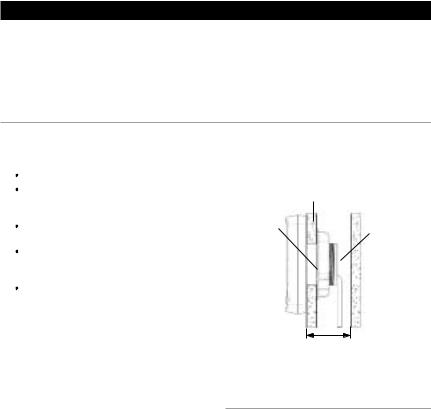
5 Installation and setup
Correct installation is critical to the performance of the unit. It is vital to read this section of the manual and the documentation that comes with the other parts before starting installation.
Warnings
The unit is waterproof from the front. Protect the rear of the unit from water, or else water might enter the
5-1 Installation
REPEAT 3100 display unit
1 Choose a location for the display unit that is:
Easily seen and protected from damage.
At least 100 mm (4") from a compass and at least 500 mm (1.65 ft) from a radio or radar antenna.
Away from engines, fluorescent lights, and power inverters.
Accessible from behind; the minimum clearance required at the back is 50 mm (2") (see right).
With the back of the unit protected from moisture.
2The unit must mount on a flat panel which is less than 20 mm (0.75") thick. Stick the mounting template in place. Drill a 50 mm (2") fixing hole through the centre hole in the template.
Note that the template allows space around the unit for the protective cover.
3Remove the fixing nut from the back of the unit. Insert the stud at the back of the unit through the mounting hole. Hand tighten the fixing nut.
Power/data cable wiring
Follow the wiring example on the next page:
1The REPEAT 3100 requires 12 V DC power. Fit a power switch and fuse to the power supply or power the unit from a fused auxiliary switch. The fuse should be 1 A for up to five NAVMAN 3100 series instruments.
2If the REPEAT 3100 is to receive data from other instruments via the NavBus, install these instruments and connect the REPEAT 3100 to the NavBus.
Note: If an instrument can be connected to the REPEAT 3100 by both NavBus and by NMEA, then use the NavBus, because more information can be shared via the NavBus (see section 3-1).
breathing hole and damage the unit. The warranty does not cover damage caused by moisture or water entering the back of the unit.
Ensure that any holes that you cut will not weaken the boat’s structure. If in doubt, consult a qualified boat builder.
Side view of display unit mounting
20 mm (0.75") maximum thickness
Fixing hole |
|
50 mm (2") |
Fixing nut |
|
Display
unit |
Cables |
|
|
|
Clearance 50 mm |
|
(2") minimum |
3If the REPEAT 3100 is to receive NMEA data from other compatible instruments, install these instruments and connect each instrument’s NMEA output to one of the three REPEAT 3100 NMEA inputs. Up to three instruments can be connected.
4Tape or cover any unused wires or connectors to protect them from water and keep them from shorting together.
Setup and test
Set up the unit as described in section 5-3. Take the boat for a trial run to check that all the instruments work correctly.
8 |
NAVMAN REPEAT 3100 Installation and Operation Manual |

REPEAT 3100 wiring example
In this example, the REPEAT 3100 receives data from a NAVMAN WIND 3100 and a SPEED 3100 via the NavBus. Any number of NAVMAN instruments can be connected to the NavBus and send data to the REPEAT 3100.
The REPEAT 3100 also receives NMEA data from a GPS and a compass. One more NMEA instrument could be connected to the third NMEA input on the REPEAT 3100.
Wire any more REPEAT 3100s in parallel with the first.
NAVMAN NavBus Instruments |
NMEA Instruments |
|
|
WIND 3100 SPEED 3100 |
GPS |
REPEAT 3100 |
Wire multiple REPEAT |
|
Compass |
|
3100 in parallel |
Other |
Other |
Other |
Other |
NMEA |
wiring |
wiring |
wiring |
wiring |
|
|
|
|
NMEA |
output |
|
|
|
|
|
|
|
|
output |
|
|
|
It does not matter which NMEA |
||
|
|
output is connected to which |
|
|
|
|
REPEAT 3100 NMEA input |
|
|
|
Orange |
Orange |
|
|
|
Blue |
Blue |
NavBus wires |
|
|
Switch Fuse |
|
Red |
|
||
Three |
Red |
|
+ 12 V DC |
12 V DC |
||
|
|
|||||
|
Black power |
|||||
NMEA |
|
|
- |
power |
||
inputs |
Black |
|
|
(see left) |
||
|
|
|
|
|
||
Green |
|
|
|
Green |
|
|
White |
|
|
|
White |
|
|
Yellow |
NavBus |
|
Yellow |
|
|
|
Unused |
|
|
|
|||
connections |
|
|
|
|
||
NMEA |
Orange |
|
|
Orange |
||
input |
|
|
||||
|
Blue |
|
|
Blue |
||
Use optional junction boxes to simplify wiring, (see right). For information on how to connect NavBus and to use junction boxes, refer to the NavBus Installation and Operation manual.
Tip: Daisychain the power wires between instruments or groups of instruments.
Group 1 |
|
Power & data |
|
Junction box connections |
|
Power/data cables |
|
|
Group 2 |
NavBus cable |
Junction box |
Power & data connections
Power/data cable
To next cluster
NAVMAN REPEAT 3100 Installation and Operation Manual |
9 |
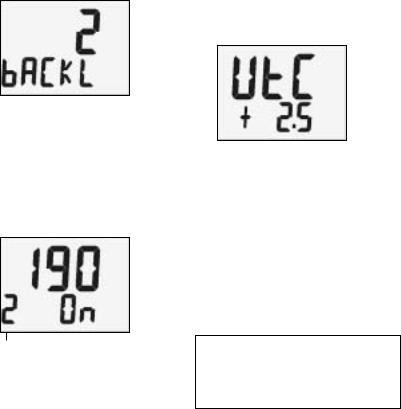
5-2 Setup
1If the unit is part of a system of 3100 series instruments connected by NavBus, set the backlight group number (see section 3-1):
iPress + +  to display the Backlight Group screen:
to display the Backlight Group screen:
Backlight group 2
iiPress  or
or  to set the backlight group number.
to set the backlight group number.
2If the unit is to display data sent by NMEA, select what NMEA data items will be displayed (see section 2-3, NMEA mode):
iEnsure that all the instruments which send NMEA data to the REPEAT 3100 are turned on and are transmitting the NMEA data.
iiPress + +  until the NMEA Selection screen is displayed:
until the NMEA Selection screen is displayed:
NMEA function number
Function can be
ON or OFF
NMEA input number, identifies which wire the NMEA data is received on
(see Appendix A, Power/data cable wires)
iiiIf a NMEA instrument has recently been
connected to or disconnected from the REPEAT 3100, press  +
+  to clear the detected NMEA strings.
to clear the detected NMEA strings.
ivThe REPEAT 3100 automatically detects NMEA data sentences from the NMEA instruments which are sending data and displays them here.
Press  or
or  to show each NMEA function in turn, note that the data value itself is not displayed.
to show each NMEA function in turn, note that the data value itself is not displayed.
For each function, use the NMEA function number to look up the data description in
the NMEA function table (see appendix B). Then press + if necessary to turn the function ON (data will be displayed) or OFF (data will not be displayed).
3If the unit is to display local time, set the UTC offset. The UTC offset will be added to the UTC (GMT) time sent from a GPS instrument to display the local time. To set the UTC offset:
iPress + +  until the UTC Offset screen is displayed:
until the UTC Offset screen is displayed:
Offset is
+ 2.5 hours
iiPress  or
or  to set the UTC offset. The range is +13 to -13 hours in 0.5 hour increments.
to set the UTC offset. The range is +13 to -13 hours in 0.5 hour increments.
Note: Daylight saving time must be adjusted manually.
4 Press  to return to normal operation.
to return to normal operation.
5-3 Resetting to factory defaults
All settings may be reset to the manufacturer’s default settings (see below).
To reset to factory defaults:
1Turn the power off.
2Hold down  +
+  while you turn the power on and continue to hold the keys down for at least 5 seconds.
while you turn the power on and continue to hold the keys down for at least 5 seconds.
SIMULATE mode .................................... |
OFF |
Backlight level ............................................ |
0 |
Backlight group .......................................... |
1 |
NMEA data to display ................ |
All are OFF |
UTC offset ........................................ |
0 hours |
10 |
NAVMAN REPEAT 3100 Installation and Operation Manual |
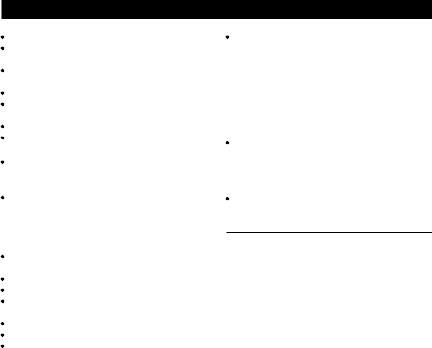
Appendix A - Specifications
Physical
Case size 111 mm (4.4") square.
LCD display 82 mm (3.2") wide, 61 mm (2.4") high; twisted nematic.
LCD digits 30 mm (1.2") high on top line, 20 mm (0.8") high on bottom line.
Four operator keys, laser etched.
Backlighting for display and keys, amber, four levels and off.
Operating temperature 0 to 50°C (32 to 122°F).
Power cable length 1 m (3.25 ft).
Electrical
Power supply 10.5 to 16.5 V DC, 20 mA without backlighting, 60 mA with full backlighting.
NavBus interface and display
NavBus interface for NAVMAN SPEED 3100, DEPTH 3100, MULTI 3100 and/or WIND 3100 instruments.
Can receive and display these values from the NavBus:
Current speed, average speed, maximum speed, trim speed.
Log: trip log and total log. Temperature.
Countdown timer (from SPEED 3100 or MULTI 3100).
Depth.
Wind speed and direction (true and apparent). VMG.
NMEA interface and display
Three NMEA 0183 inputs for compatible NMEA instruments.
Can receive and display these NMEA sentences:
APB, BEC, BOD, BWC, BWR, BWR, DBT, DPT, GGA, GNS, HDG, HDT, HSC, MTW, MWD, MWV, RMA, RMB, RMC, VDR, VHW, VLW, VPW, VTG, WCV, XTE, XTR, ZDA (see Appendix B).
Standards compliance
EMC compliance:
USA (FCC): Part 15 Class B.
Europe (CE): EN50081-1, EN50082-1.
New Zealand and Australia (C Tick): AS-NZS 3548.
Environment: IP66 from front when correctly mounted.
Power/data cable wires
Wire |
Signal |
Red |
Power positive, 12 V DC |
Black |
Power negative, NMEA common |
Orange |
NavBus + |
Blue |
NavBus - |
White |
NMEA input 1 |
Yellow |
NMEA input 2 |
Green |
NMEA input 3 |
NAVMAN REPEAT 3100 Installation and Operation Manual |
11 |

Appendix B - NMEA function table
Item |
Function |
Units |
|
|
NMEA |
|
|
No. |
|
|
sentence |
|
|
||
|
|
|
|
|
|||
110 |
Depth |
Meters |
|
|
DPT |
|
|
120 |
Depth |
Feet |
|
|
DBT |
|
|
130 |
Depth |
Meters |
|
|
DBT |
|
|
140 |
Depth |
Fathoms |
|
|
DBT |
|
|
150 |
Boat Speed |
Knots |
|
|
VHW |
|
|
160 |
Boat Speed |
Kph |
|
|
VHW |
|
|
170 |
Trip Distance |
Nautical Miles |
|
|
VLW |
|
|
180 |
Total Distance |
Nautical Miles |
|
|
VLW |
|
|
190 |
Water Temperature |
Degrees Celsius |
|
|
MTW |
|
|
200 |
Wind Speed |
Units specified in sentence (True or |
|
MWV |
|
|
|
Apparent and Kph, m/s, or Knots) |
|
|
|||||
|
|
|
|
|
|
||
210 |
Wind Speed |
True, Knots |
|
|
MWD |
|
|
220 |
Wind Speed |
True, m/s |
|
|
MWD |
|
|
230 |
Wind Direction |
Dir type specified in sentence (True or |
|
MWV |
|
|
|
Apparent) |
|
|
|
||||
|
|
|
|
|
|
|
|
240 |
Magnetic Wind Direction |
Degrees |
|
|
MWD |
|
|
250 |
Speed Parallel to Wind |
Knots |
|
|
VPW |
|
|
260 |
Speed Parallel to Wind |
m/s |
|
|
VPW |
|
|
270 |
Current Set |
Degrees True |
|
|
VDR |
|
|
280 |
Current Set |
Degrees Magnetic |
|
VDR |
|
|
|
290 |
Current Drift |
Knots |
|
|
VDR |
|
|
300 |
Heading |
Degrees True |
|
|
VHW |
|
|
310 |
Heading |
Degrees Magnetic |
|
VHW |
|
|
|
320 |
Heading |
Degrees True |
|
|
HDG |
|
|
330 |
Heading |
Degrees Magnetic |
|
HDG |
|
|
|
340 |
Heading |
Degrees True |
|
|
HDT |
|
|
350 |
Position |
Degrees, Minutes |
|
GGA |
|
|
|
360 |
Position |
Degrees, Minutes |
|
GNS |
|
|
|
370 |
Position |
Degrees, Minutes |
|
RMA |
|
|
|
380 |
Position |
Degrees, Minutes |
|
RMC |
|
|
|
390 |
Speed Over Ground (SOG) |
Knots |
|
|
RMA |
|
|
400 |
Speed Over Ground (SOG) |
Knots |
|
|
RMC |
|
|
410 |
Speed Over Ground (SOG) |
Knots |
|
|
VTG |
|
|
420 |
Speed Over Ground (SOG) |
Kph |
|
|
VTG |
|
|
430 |
Course Over Ground (COG) |
Degrees True |
|
|
RMA |
|
|
440 |
Course Over Ground (COG) |
Degrees Magnetic |
|
RMA |
|
|
|
450 |
Course Over Ground (COG) |
Degrees True |
|
|
RMC |
|
|
460 |
Course Over Ground (COG) |
Degrees Magnetic |
|
RMC |
|
|
|
470 |
Course Over Ground (COG) |
Degrees True |
|
|
VTG |
|
|
480 |
Course Over Ground (COG) |
Degrees Magnetic |
|
VTG |
|
|
|
490 |
Bearing To Waypoint (BTW) |
Type specified in sentence (True or Magnetic) |
|
APB |
|
|
|
500 |
Bearing To Waypoint (BTW) |
Degrees True |
|
|
BEC |
|
|
510 |
Bearing To Waypoint (BTW) |
Degrees Magnetic |
|
BEC |
|
|
|
520 |
Bearing To Waypoint (BTW) |
Degrees True |
|
|
BWC |
|
|
530 |
Bearing To Waypoint (BTW) |
Degrees Magnetic |
|
BWC |
|
|
|
540 |
Bearing To Waypoint (BTW) |
Degrees True |
|
|
BWR |
|
|
550 |
Bearing To Waypoint (BTW) |
Degrees Magnetic |
|
BWR |
|
|
|
560 |
Bearing To Waypoint (BTW) |
Degrees True |
|
|
RMB |
|
|
570 |
Distance To Waypoint (DTW) |
Nautical Miles |
|
|
BEC |
|
|
580 |
Distance To Waypoint (DTW) |
Nautical Miles |
|
|
BWC |
|
|
590 |
Distance To Waypoint (DTW) |
Nautical Miles |
|
|
BWR |
|
|
600 |
Distance To Waypoint (DTW) |
Nautical Miles |
|
|
RMB |
|
|
610 |
Heading To Steer (HTS) |
Type specified in sentence (True or Magnetic) |
|
APB |
|
|
|
620 |
Heading To Steer (HTS) |
Degrees True |
|
|
HSC |
|
|
630 |
Heading To Steer (HTS) |
Degrees Magnetic |
|
HSC |
|
|
|
640 |
Cross Track Error (CTE) |
Nautical Miles |
NAVMAN REPEAT 3100 Installation |
APB |
|
|
|
12 |
|
|
and Operation Manual |
|
|||
|
|
|
|
|
|
|
|
